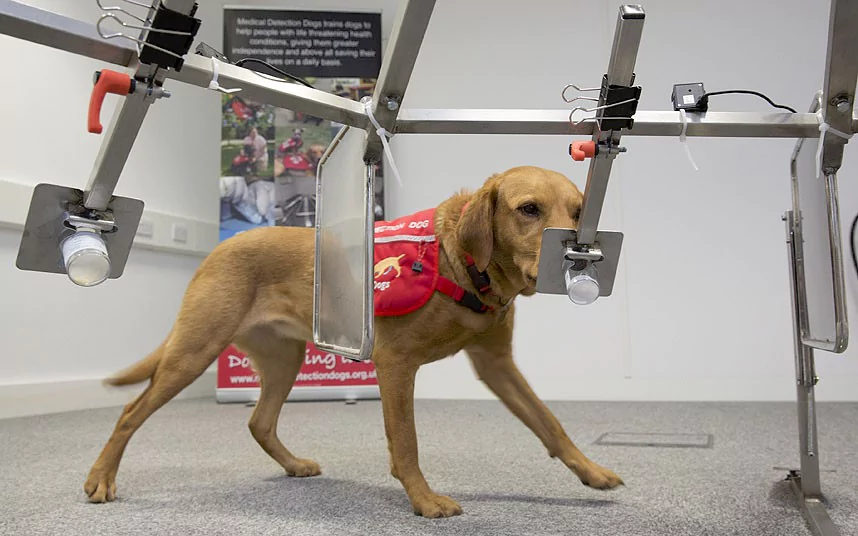Dogs Can Smell Cancer, Hospitals Already Using Them
It\’s true. Man\’s best friend can be trained to become a cancer-sniffing master using his sensitive noses to detect cancerous fumes coming from infected cells. This sniffing is a noninvasive approach which could help diagnose a number of people. But, if our furry, four-legged friends have such powerful noses, why aren\’t they screening people for cancer right now?
The thing is, dogs are really helpful to our law enforcement when it comes to tracking scents or leading search-and-rescue teams in disaster areas. However, imagine having to sniff hundreds of thousands of samples in which only a few may be infected with cancerous! It\’s not that easy and it has little positive reinforcement.
Furthermore, these pups would need to undergo extensive training, and even when they do, they still might misdiagnose someone if they\’re having a bad day. Nevertheless, their role in developing manmade screening instruments that smell cancer is crucial. Scientists already know that diseased cancerous cells emit unique scents, but they still haven\’t discovered the specific compounds responsible for these odors.
The dogs might be able to identify cancer-specific odors if they are given certain cancerous samples to smell, after which compounds could be slowly removed. According to Dr. Hilary Brodie, a professor in the Department of Otolaryngology at the University of California, Davis, if the dog stops responding to the sample after several components have been removed, then you know you\’ve taken out a cancer-specific component of the mixture. Afterward, these individual components could be analyzed, ultimately leading to the development of biochemical tests that could effectively screen patients.
Sharp Smell
The first report dealing with dog sniffing was actually published in 1989 by the British journal The Lancet. The editor received a letter from two dermatologists describing how a dog supposedly sniffed a colored lesion on its owner\’s thigh for several minutes every day. At one point, the dog even tried to bite off the spot. Distraught, the woman went to the doctor and had the lesion inspected, which in the end turned out to be a malignant melanoma.
Therefore, the dog may have saved the woman\’s life, by making her seek medical treatment when the lesion was still at a curable phase.
There were other reports of dogs identifying malignant melanoma, but high-quality, double-blinded studies were published several years later. And soon, countless studies proved that trained dogs could detect certain cancers by sniffing biological samples, like a person\’s urine or breath. This is due to the fact that cells, even diseased ones, give off volatile organic compounds (VOCs). And all types of cancer have a distinct VOC, which means a different odor compared to other cells.
Since a dog\’s nose contains more than 220 million smell receptors, they\’re the perfect animals for sniffing out this disease. Humans, on the other hand, have only 5 million smell receptors in their noses.
Dog Training
Dr. Klaus Hackner, a pulmonary physician at Krems University Hospital in Austria believes most dogs can be trained to detect the odor of certain cancer in about 6 months. However, many studies relied on setups that would only work in laboratories, and not in a reality. Often the dog would be given five samples out of which one was always cancerous. In the real world, a sniffer dog may recognize just four cancerous samples out of a batch of 1,000.
Hackner says that if neither the handler nor the dog knows which four out of the 1,000 are cancerous, the dog won\’t receive positive reinforcement from the handler when it chooses the right sample.
This could be fixed if there was always one planted cancerous specimen in each set. In that way, the dog could be rewarded and wouldn\’t be bored after sniffing thousands of noncancerous samples from patients.
The Future
Even if we could change the setup to accommodate the dogs, it wouldn\’t be a realistic method to screen patients. It would take a lot of effort and many resources to train dogs to detect the great number of cancers. And, while there\’s no such thing as a perfect test, doctors at least know how accurate they are. For instance, they know what rate mammograms give off false positives and false negatives. But, this would vary in dogs.
In addition, dogs could get hungry, bored or have a bad day, same as humans.
Instead, researchers are actually hoping that dogs could help them create and improve biochemical “nose” machines, or e-noses, that could be able to “sniff” patients and give diagnoses. These machines are already available for some conditions but could become more sensitive to more diseases with the help of dogs.
So, pay more attention to what your dog\’s trying to show you. He might be able to save your life someday!


